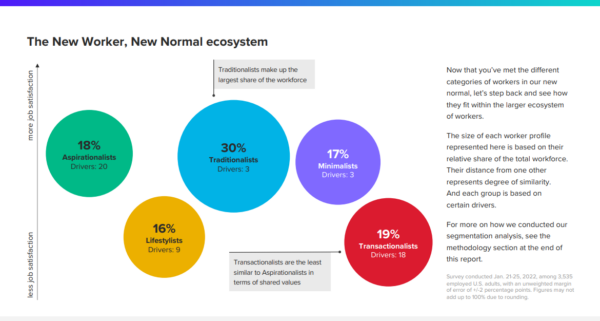The 5 new employee types and how to reach them
New research from Morning Consult identifies five common employee archetypes and recommends ways for communicators to use these profiles to guide engagement.

Increasing employee retention often means getting out ahead of problems that might cause workers to leave. So, how can companies determine what employees like — and dislike — most about their workplaces?
According to a new report from Morning Consult, modern workers fall into one of five archetypes, from most to least common:
- Traditionalists: “A job is just a job,” is these workers’ motto, with many reporting high job satisfaction and a strong preference for in-person work. Traditionalists are most likely to work hourly jobs.
- Transactionalists: These employees skew younger, and of the five types have the highest percentage of Gen Z workers. Transactionalists report lower job satisfaction and tend to not prioritize career growth. They are least likely to have work benefits (including health care) and are often employed part time.
- Aspirationalists: These are the workers who are driven by career purpose, finding high levels of job satisfaction and who feel most fulfilled by work. Aspirationalists “live to work” and are most likely to be millennials with dependents.
- Minimalists: Employees in this category don’t expect a lot from their jobs. While they don’t often prioritize their work, minimalists are relatively satisfied with their jobs. They also skew male and are most likely to be remote or hybrid, as well as salaried.
- Lifestylists: These workers have the strongest preference for remote jobs and see work as a means to support their personal priorities. Lifestylists skew female and are less likely to have dependents.
According to Charlotte Principato, a financial services analyst with Morning Consult, determining which categories your employees fall into is the key to worker satisfaction.
“You can’t just craft one sort of message and assume it’s going to resonate with everyone,” she says. “And you can’t even assume it’s going to resonate with a majority of employees.”

Among other assumptions to avoid is the idea that everyone is satisfied with how their job fits into their personal lives.
“I think if more employers broadened the aperture to say, ‘Let’s understand our employees as people first and employees second,’ you’d naturally create a better understanding and be able to better offer what they need,” Principato notes.
Assuming that all of your employees come to work for the same reasons is a surefire way to undermine your internal comms strategy.
Principato suggests using pulse surveys to directly ask employees a traditionally awkward question: If you were to leave this job for another one, what would it be for?
“It’s not just important to ask your employees how well you’re doing at something, it’s important to ask them what they’re looking for in another [employer] that might make them leave,” she says.
Comms pros, have you considered how your employees’ work and personal priorities differ from your assumptions? How does this inform your messaging strategy? Let us know on Twitter @RaganComms.







